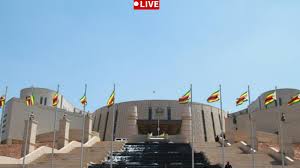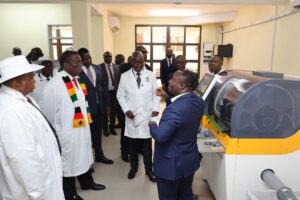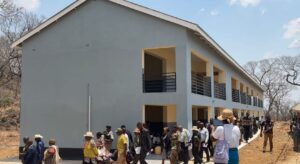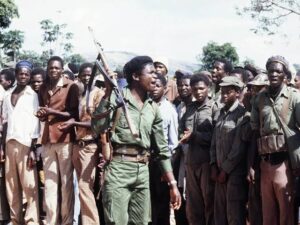2025 SONA Speaks to National Growth, Resilience and Purpose
5 min read
SPECIAL – His Excellency the President Dr. Emmerson Dambudzo Mnangagwa today, delivered a firmly optimistic State of the Nation Address (SONA), declaring that Zimbabwe is on an “irreversible path towards economic stability, industrial growth and social transformation,” as he officially opened the Third Session of the Tenth Parliament of Zimbabwe at the New Parliament Building in Mt. Hampden.
The address came at the back of the commemorations of the SADC Anti-Sanctions Day, and the President once again condemned the impact of punitive Western sanctions, accusing them of stalling development while praising Zimbabweans for resilience, unity and patriotism.

He reaffirmed that despite the sanctions, “the unity, peace and resilience of our people have been the pillar of economic development,” adding that Zimbabwe must “remain focused and disciplined” in its journey toward Vision 2030.
President Mnangagwa announced that Zimbabwe’s economy is projected to grow by 6.6 percent in 2025, driven largely by agriculture, mining, manufacturing and infrastructure development.
He attributed this strong performance to robust policy implementation, particularly under the Agriculture, Food Systems and Rural Transformation Strategy.
He highlighted record harvests in maize, tobacco and wheat, crediting the Pfumvudza/Intwasa conservation farming programme for empowering more than 3 million rural households with farming inputs.
“We are building climate resilience and food security from the village up,” he said.

The President also reported progress in livestock production, revealing that the national herd now stands at 5.7 million, while national milk output has increased from 76.7 million litres in 2019 to 115 million litres in 2024.
Massive expansion in irrigation infrastructure remains a key thrust of rural development. The irrigated land area has risen to 221,000 hectares from 151,000 hectares in 2019, with a national target of 496,000 hectares in sight.
Rural Development 8.0, centred on water access for communities and production, has seen thousands of boreholes drilled to support village business units.
The President said the mining sector continues to expand, with rising investments in gold refining, iron and steel production and lithium beneficiation.
He emphasized the government’s stance on responsible mining, saying, “We will not tolerate pollution and environmental degradation. Investors must respect our laws, culture and people.”
New industrial projects have boosted manufacturing output, contributing 15.3 percent to the national GDP.
Growth has been anchored in priority value chains including steel, cement, pharmaceuticals, textiles and dairy.
The President noted that the Zimbabwe Industrial Reconstruction and Growth Plan and Community Economic Empowerment Trusts provide new opportunities for resource-based industrialization at community level.

Tourism emerged as one of the fastest growing sectors in 2025, with Zimbabwe named “Best Must-Visit Destination in the World” by Forbes Magazine. Mnangagwa hailed the recognition as a milestone for Brand Zimbabwe, “Tourism is now a pillar of economic transformation,” he said, urging Parliament to expedite the Tourism Amendment Bill to modernize the sector and encourage investment.
Zimbabwe’s energy sector has long struggled to meet industrial demand, but the President reported notable progress driven by Independent Power Producers (IPPs) and captive power initiatives.
He revealed that new energy projects have already begun feeding electricity into the national grid.
Rural electrification is accelerating, with thousands of public institutions, schools and homesteads connected to power through government-funded infrastructure.
Fuel supplies also remain stable, thanks to an expansion of pipeline capacity from 2.6 billion litres to 3 billion litres per year, set to rise to 5 billion litres in coming years.
Infrastructure development remains at the heart of Mnangagwa’s administration.
He confirmed progress on several flagship road projects including the Harare–Chirundu Highway, Bulawayo–Victoria Falls Road, Christmas Pass Bypass, and upgrades at Chirundu and Forbes border posts.
The newly-completed Trafigura-linked Trabablas Interchange in Harare was cited as a milestone in easing urban traffic.
Digital transformation is also underway in public transport administration through the Zimbabwe Integrated Transport Information Management System, automating services at VID, CVR and Road Motor Transport.
President Mnangagwa applauded progress made in stabilizing the local currency, the ZiG, and reducing inflation through strict fiscal and monetary discipline.
He announced that foreign currency inflows reached US$10.4 billion by August 2025, a 26.8 percent increase from 2024.
Foreign currency reserves also grew from US$700 million in June 2025 to US$900 million by September.
He said Zimbabwe was ranked first globally by the World Bank among countries making the greatest progress in foreign currency reserve accumulation.
President Mnangagwa reaffirmed his government’s commitment to inclusive development, announcing continued support for vulnerable citizens under safety net programmes such as:
• Food Deficit Mitigation Programme
• Basic Education Assistance Module (BEAM)
• Vulnerable Input Scheme
He noted ongoing investment in hospitals and clinics under the Health Sector Modernisation Programme, focusing on digital healthcare, maternal and child care, and non-communicable diseases.
In education, the government is expanding rural schools, student financing and vocational training centres to equip youth with practical skills.
In a forward-looking section of the speech, Mnangagwa highlighted the adoption of the National Artificial Intelligence Strategy, which seeks to harness AI for economic transformation.
The Digital Ambassadors Programme has already equipped thousands of young Zimbabweans with digital literacy, while innovation hubs in universities are now commercialising local research.
The President delivered a stern reminder to Parliament to accelerate stalled legislation.
He described the backlog of uncompleted Bills as “unacceptable,” naming the Mines and Minerals Amendment Bill, Public Procurement Bill, Persons with Disabilities Bill and Occupational Safety and Health Bill among those requiring urgent attention.
He also outlined new Bills for the 2025-2026 legislative session, including:
• Disaster Risk Management Bill
• Zimbabwe Media Commission Amendment Bill
• Foreign Affairs and International Trade Bill
• National Languages Bill
• Sports Integrity Bill
• Defence Amendment Bill
• Civil Aviation Bill
Devolution remains a key governance priority, with all 92 local councils now operating under modernised Master Plans.
The President reassured veterans of the liberation struggle of continued financial and economic support through empowerment funds and business programmes.
He also launched the National Youth Empowerment Strategy (2026–2030), aimed at youth participation in national development.
He condemned the growing problem of drug and substance abuse, calling it “a national threat,” and commended stakeholders, including the Angel of Hope Foundation, for joining the national fight.
Closing his address, President Mnangagwa called for unity and productivity ahead of the 2025/26 agricultural season.
He reiterated his development mantra:
“Nyika inovakwa, igotongwa, igonamatirwa nevene vayo — Ilizwe lakhiwa, libuswe, likhulekelwe ngabanikazi balo.”
He added, “We are building Zimbabwe step by step, brick by brick, stone upon stone.There is no turning back. Forward ever, backward never.”
With that, he officially opened the Third Session of the Tenth Parliament.




